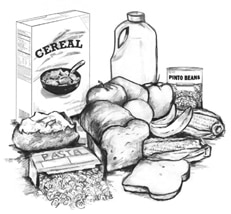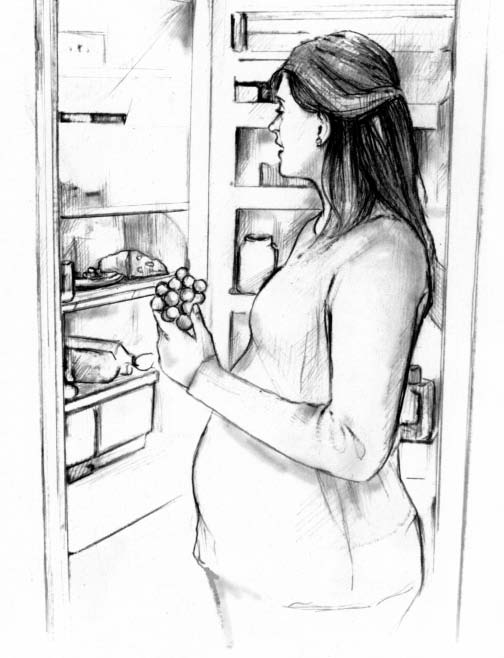What is carbohydrate counting?
Carbohydrate counting, also called carb counting, is a meal planning tool for people with type 1 or type 2 diabetes. Carbohydrate counting involves keeping track of the amount of carbohydrate in the foods you eat each day.
Carbohydrates are one of the main nutrients found in food and drinks. Protein and fat are the other main nutrients. Carbohydrates include sugars, starches, and fiber. Carbohydrate counting can help you control your blood glucose, also called blood sugar, levels because carbohydrates affect your blood glucose more than other nutrients.
Healthy carbohydrates, such as whole grains, fruits, and vegetables, are an important part of a healthy eating plan because they can provide both energy and nutrients, such as vitamins and minerals, and fiber. Fiber can help you prevent constipation, lower your cholesterol levels, and control your weight.
Unhealthy carbohydrates are often food and drinks with added sugars. Although unhealthy carbohydrates can also provide energy, they have little to no nutrients. More information about which carbohydrates provide nutrients for good health and which carbohydrates do not is provided in the NIDDK health topic, Diabetes Diet and Eating.
The amount of carbohydrate in foods is measured in grams. To count grams of carbohydrate in foods you eat, you’ll need to
- know which foods contain carbohydrates
- learn to estimate the number of grams of carbohydrate in the foods you eat
- add up the number of grams of carbohydrate from each food you eat to get your total for the day
Your doctor can refer you to a dietitian or diabetes educator who can help you develop a healthy eating plan based on carbohydrate counting.
Which foods contain carbohydrates?
Foods that contain carbohydrates include
- grains, such as bread, noodles, pasta, crackers, cereals, and rice
- fruits, such as apples, bananas, berries, mangoes, melons, and oranges
- dairy products, such as milk and yogurt
- legumes, including dried beans, lentils, and peas
- snack foods and sweets, such as cakes, cookies, candy, and other desserts
- juices, soft drinks, fruit drinks, sports drinks, and energy drinks that contain sugars
- vegetables, especially “starchy” vegetables such as potatoes, corn, and peas
Potatoes, peas, and corn are called starchy vegetables because they are high in starch. These vegetables have more carbohydrates per serving than nonstarchy vegetables.
Examples of nonstarchy vegetables are asparagus, broccoli, carrots, celery, green beans, lettuce and other salad greens, peppers, spinach, tomatoes, and zucchini.
Foods that do not contain carbohydrates include meat, fish, and poultry; most types of cheese; nuts; and oils and other fats.

Foods that contain carbohydrates include grains,fruits, dairy products, vegetables, and legumes.
What happens when I eat foods containing carbohydrates?
When you eat foods containing carbohydrates, your digestive system breaks down the sugars and starches into glucose. Glucose is one of the simplest forms of sugar. Glucose then enters your bloodstream from your digestive tract and raises your blood glucose levels. The hormone insulin, which comes from the pancreas or from insulin shots, helps cells throughout your body absorb glucose and use it for energy. Once glucose moves out of the blood into cells, your blood glucose levels go back down.
How can carbohydrate counting help me?
Carbohydrate counting can help keep your blood glucose levels close to normal. Keeping your blood glucose levels as close to normal as possible may help you
- stay healthy longer
- prevent or delay diabetes problems such as kidney disease, blindness, nerve damage, and blood vessel disease that can lead to heart attacks, strokes, and amputations—surgery to remove a body part
- feel better and more energetic
You may also need to take diabetes medicines or have insulin shots to control your blood glucose levels. Discuss your blood glucose targets with your doctor. Targets are numbers you aim for. To meet your targets, you will need to balance your carbohydrate intake with physical activity and diabetes medicines or insulin shots.

How much carbohydrate do I need each day?
The daily amount of carbohydrate, protein, and fat for people with diabetes has not been defined—what is best for one person may not be best for another. Everyone needs to get enough carbohydrate to meet the body’s needs for energy, vitamins and minerals, and fiber.
Experts suggest that carbohydrate intake for most people should be between 45 and 65 percent of total calories. People on low-calorie diets and people who are physically inactive may want to aim for the lower end of that range.
One gram of carbohydrate provides about 4 calories, so you’ll have to divide the number of calories you want to get from carbohydrates by 4 to get the number of grams. For example, if you want to eat 1,800 total calories per day and get 45 percent of your calories from carbohydrates, you would aim for about 200 grams of carbohydrate daily. You would calculate that amount as follows:
- .45 x 1,800 calories = 810 calories
- 810 ÷ 4 = 202.5 grams of carbohydrate
You’ll need to spread out your carbohydrate intake throughout the day. A dietitian or diabetes educator can help you learn what foods to eat, how much to eat, and when to eat based on your weight, activity level, medicines, and blood glucose targets.

How can I find out how much carbohydrate is in the foods I eat?
You will need to learn to estimate the amount of carbohydrate in foods you typically eat. For example, the following amounts of carbohydrate-rich foods each contain about 15 grams of carbohydrate:
- one slice of bread
- one 6-inch tortilla
- 1/3 cup of pasta
- 1/3 cup of rice
- 1/2 cup of canned or fresh fruit or fruit juice or one small piece of fresh fruit, such as a small apple or orange
- 1/2 cup of pinto beans
- 1/2 cup of starchy vegetables such as mashed potatoes, cooked corn, peas, or lima beans
- 3/4 cup of dry cereal or 1/2 cup cooked cereal
- 1 tablespoon of jelly
Some foods are so low in carbohydrates that you may not have to count them unless you eat large amounts. For example, most nonstarchy vegetables are low in carbohydrates. A 1/2-cup serving of cooked nonstarchy vegetables or a cup of raw vegetables has only about 5 grams of carbohydrate.
As you become familiar with which foods contain carbohydrates and how many grams of carbohydrate are in food you eat, carbohydrate counting will be easier.
Nutrition Labels
You can find out how many grams of carbohydrate are in the foods you eat by checking the nutrition labels on food packages. Following is an example of a nutrition label:

Nutrition labels tell you the total grams of carbohydrate per serving, along with other nutrition information.
Nutrition labels tell you
- the food’s serving size––such as one slice or 1/2 cup
- the total grams of carbohydrate per serving
- other nutrition information, including calories and the amount of protein and fat per serving
If you have two servings instead of one, such as one cup of pinto beans instead of 1/2 cup, you multiply the number of grams of carbohydrate in one serving—for example, 15—by two to get the total number of grams of carbohydrate—30.
15 x 2 = 30
Cooking at Home
To find out the amount of carbohydrate in homemade foods, you’ll need to estimate and add up the grams of carbohydrate from the ingredients. You can use books or websites that list the typical carbohydrate content of homemade items to estimate the amount of carbohydrate in a serving.
You can also weigh foods with a scale or measure amounts with measuring cups or spoons to estimate the amount of carbohydrate. For example, if a nutrition label shows that 1 1/2 cups of cereal contain 45 grams of carbohydrate, then 1/2 cup will have 15 grams of carbohydrate and 1 cup will have 30 grams of carbohydrate.
Eating Out
Some restaurants provide nutrition information that lists grams of carbohydrate. You can also use carbohydrate counting food lists to estimate the amount of carbohydrate in restaurant meals.
Can I eat sweets and other foods and drinks with added sugars?
Yes, you can eat sweets and other foods and drinks with added sugars. However, you should limit your intake of these high-carbohydrate foods and drinks because they are often high in calories and low in vitamins, minerals, and fiber. Fiber-rich whole grains, fruits, vegetables, and beans are wiser choices.
Instead of eating sweets every day, try eating them in small amounts once in a while so you don’t fill up on foods that are low in nutrition. Ask your dietitian or diabetes educator about including sweets in your eating plan.
How can I tell whether carbohydrate counting is working for me?
Checking your blood glucose levels can help you tell whether carbohydrate counting is working for you. You can check your blood glucose levels using a glucose meter.
You should also have an A1C blood test at least twice a year. The A1C test reflects the average amount of glucose in your blood during the past 3 months.
If your blood glucose levels are too high, you may need to make changes in your eating plan or other lifestyle changes. For example, you may need to make wiser food choices, be more physically active, or make changes to your diabetes medicines. Talk with your doctor about what changes you need to make to control your blood glucose levels.
If you use an insulin pump or take more than one daily insulin shot, ask your doctor how to adjust your insulin when you eat something that isn’t in your usual eating plan.

Can I use carbohydrate counting if I am pregnant?
You can use carbohydrate counting to help control your blood glucose levels when you are pregnant. Meeting your blood glucose targets during pregnancy is important for your and your baby’s health. High blood glucose during pregnancy can harm the baby and increase the baby’s chances of having type 2 diabetes later in life.
Women diagnosed with gestational diabetes—a type of diabetes that develops only during pregnancy—can also use carbohydrate counting to help control their blood glucose levels.
Talk with your doctor about using carbohydrate counting to help meet your blood glucose targets during your pregnancy.

More information about diabetes during pregnancy is provided in the NIDDK health topics:
- What I need to know about Preparing for Pregnancy if I Have Diabetes
- What I need to know about Gestational Diabetes
Where can I find more help with carbohydrate counting?
The Internet has carbohydrate counting tools that let you enter a type of food and find out what nutrients the food contains, including carbohydrates. Try visiting these sites:
- www.diabetes.org/mfa-recipes/ —a calorie and carbohydrate counting tool from the American Diabetes Association (ADA)
- www.nal.usda.gov/fnic/foodcomp/search —an online database from the U.S. Department of Agriculture Nutrient Data Lab
Points to Remember
- Carbohydrate counting is a meal planning tool for people with type 1 or type 2 diabetes. Carbohydrate counting involves keeping track of the amount of carbohydrate in the foods you eat each day.
- Carbohydrates are one of the main nutrients found in food and drinks. Carbohydrates include sugars, starches, and fiber.
- Carbohydrate counting can help you control your blood glucose, also called blood sugar, levels because carbohydrates affect your blood glucose more than other nutrients.
- Carbohydrates are an important part of a healthy eating plan because they provide energy. Most foods containing carbohydrates also contain important vitamins and minerals. Many foods that contain carbohydrates are good sources of fiber, which can help you prevent constipation, lower your cholesterol levels, and control your weight.
- To count carbohydrates, you’ll need to know which foods contain carbohydrates and learn to estimate the number of grams of carbohydrate in the foods you eat. Then you’ll add up the number of grams of carbohydrate from each food you eat to get your total for the day.
- Foods that contain carbohydrates include grains, fruits, dairy products, vegetables, legumes, snack foods and sweets, and drinks that contain sugar. When you eat carbohydrates, your digestive system breaks down the sugars and starches into glucose.
- To meet your blood glucose targets, you will need to balance your carbohydrate intake with physical activity and diabetes medicines or insulin shots.
- Nutrition labels on food packages tell you the food’s serving size, the total grams of carbohydrate per serving, and other nutrition information.
- Foods and drinks with added sugars are high-carbohydrate foods that are often high in calories and low in vitamins, minerals, and fiber. Fiber-rich whole grains, fruits, vegetables, and beans are wiser choices.
Clinical Trials
The National Institute of Diabetes and Digestive and Kidney Diseases (NIDDK) and other components of the National Institutes of Health (NIH) conduct and support research into many diseases and conditions.
What are clinical trials, and are they right for you?
Clinical trials are part of clinical research and at the heart of all medical advances. Clinical trials look at new ways to prevent, detect, or treat disease. Researchers also use clinical trials to look at other aspects of care, such as improving the quality of life for people with chronic illnesses. Find out if clinical trials are right for you .
Clinical trials are part of clinical research and at the heart of all medical advances. Clinical trials look at new ways to prevent, detect, or treat disease. Researchers also use clinical trials to look at other aspects of care, such as improving the quality of life for people with chronic illnesses. Find out if clinical trials are right for you .
What clinical trials are open?
Clinical trials that are currently open and are recruiting can be viewed at www.ClinicalTrials.gov .
Clinical trials that are currently open and are recruiting can be viewed at www.ClinicalTrials.gov .
June 2014
Alternate Versions
Additional Links
This content is provided as a service of the National Institute of Diabetes and Digestive and Kidney Diseases (NIDDK), part of the National Institutes of Health. The NIDDK translates and disseminates research findings through its clearinghouses and education programs to increase knowledge and understanding about health and disease among patients, health professionals, and the public. Content produced by the NIDDK is carefully reviewed by NIDDK scientists and other experts.
The NIDDK would like to thank:
Marion J. Franz, M.S., R.D., L.D., C.D.E., Nutrition Concepts by Franz, Inc.; Hope Warshaw, M.M.Sc., R.D., C.D.E., Hope Warshaw Associates, LLC
Marion J. Franz, M.S., R.D., L.D., C.D.E., Nutrition Concepts by Franz, Inc.; Hope Warshaw, M.M.Sc., R.D., C.D.E., Hope Warshaw Associates, LLC
Fauquier Wellness Center and Inova Diabetes Center Support Group for facilitating field-testing of this publication.
沒有留言:
張貼留言